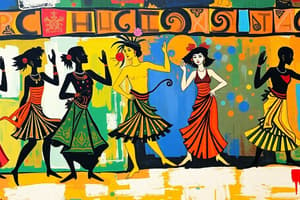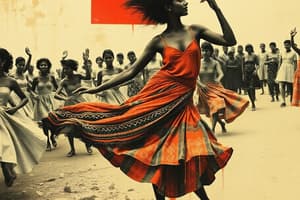Podcast
Questions and Answers
For what reasons do people primarily dance?
For what reasons do people primarily dance?
- To please gods (correct)
- To please themselves (correct)
- To build community within an ethnic group (correct)
- To please others (correct)
What is the origin of the word 'dance'?
What is the origin of the word 'dance'?
It comes from the German word damson, which means 'to stretch' or 'to drag'.
Dance during the prehistoric period was primarily a form of entertainment.
Dance during the prehistoric period was primarily a form of entertainment.
False (B)
Which ancient civilization is believed to have first danced?
Which ancient civilization is believed to have first danced?
What were the three major dancers in Ancient Egypt?
What were the three major dancers in Ancient Egypt?
Plato believed that dance was unimportant in education.
Plato believed that dance was unimportant in education.
What significant event contributed to the popularity of ballet in the Renaissance?
What significant event contributed to the popularity of ballet in the Renaissance?
Tap dancing originated from __________ tribe dancing.
Tap dancing originated from __________ tribe dancing.
What does modern tap dancing involve?
What does modern tap dancing involve?
What is the origin of the word 'dance'?
What is the origin of the word 'dance'?
What are the four main reasons why people dance?
What are the four main reasons why people dance?
What role did shamans play in prehistoric dance?
What role did shamans play in prehistoric dance?
In which civilization is it believed that the first people to dance originated?
In which civilization is it believed that the first people to dance originated?
Which of the following dancers were present in Ancient Egypt?
Which of the following dancers were present in Ancient Egypt?
Dance was considered unimportant in Ancient Greece.
Dance was considered unimportant in Ancient Greece.
Match the following historical periods with their dance characteristics:
Match the following historical periods with their dance characteristics:
What was Masque dancing?
What was Masque dancing?
What era influenced Classical Persian dancing?
What era influenced Classical Persian dancing?
What is tap dancing derived from?
What is tap dancing derived from?
The lady of the arts, _______ de Medici, helped popularize ballet.
The lady of the arts, _______ de Medici, helped popularize ballet.
Flashcards are hidden until you start studying
Study Notes
Definition and Purpose of Dance
- Originates from the German word "damson," meaning "to stretch" or "to drag."
- Serves as a natural expression of collective feeling and action.
- Acts as a societal mirror, reflecting historical, religious, and political contexts.
- Primarily performed for four reasons: to please gods, others, oneself, and to build community within ethnic groups.
Historical Development of Dance
Prehistoric Period
- Major form of religious ritual and social expression in primitive cultures.
- Used to reinforce tribal unity, based on superstition and magic.
- Shamans, acting as lead dancers, served as healers and religious leaders.
Ancient Civilizations
-
Ancient Egypt (c. 3,300 BCE)
- Earliest known dancers were Egyptians, depicted in rock art.
- Dance used in religious service and ancient myth education.
- Key figures: kings, priests (performing magical dances), and trained virgin dancers.
-
Ancient Crete (c. 3000-1400 BC)
- Cultural link between Egyptians and Greeks.
- Dance utilized for military training and excellence.
-
Ancient Greece
- Dance combined religious purposes, military training, and entertainment.
- Plato emphasized dance in education, distinguishing between noble and ignoble forms.
-
Ancient Rome
- Initially unappreciated, later condemned by early Christians.
- Dance was integral to religious and social occasions but faced restrictions.
Middle Ages and Renaissance
- Dance gained popularity around 1500; marked by the rise of ballet.
- Catherine de Medici's marriage to King Henry II stimulated ballet festivals.
- Ballet established a core influence on many dance forms across Europe.
Modern Dance History
16th and 17th Centuries
- Masque Dancing emerging from elaborate pageants, combining dancing with acting and singing, primarily for court entertainment.
- France became the leading nation in dance during this period.
18th Century
-
Classical Persian Dancing (1795)
- Originated from courtroom dancing during the Qajar Dynasty (1795-1925).
- Dancers performed lively routines for the Shah, accompanied by small bands.
-
Tap Dancing (1800)
- Evolved from African tribe dances with shoes designed to create percussive sounds.
- Remains a popular dance style today.
19th Century
- Merengue Dancing (1890)
- A Caribbean dance characterized by partners holding a tango-like position, symbolizing dynamic cultural expression.
Definition and Purpose of Dance
- Originates from the German word "damson," meaning "to stretch" or "to drag."
- Serves as a natural expression of collective feeling and action.
- Acts as a societal mirror, reflecting historical, religious, and political contexts.
- Primarily performed for four reasons: to please gods, others, oneself, and to build community within ethnic groups.
Historical Development of Dance
Prehistoric Period
- Major form of religious ritual and social expression in primitive cultures.
- Used to reinforce tribal unity, based on superstition and magic.
- Shamans, acting as lead dancers, served as healers and religious leaders.
Ancient Civilizations
-
Ancient Egypt (c. 3,300 BCE)
- Earliest known dancers were Egyptians, depicted in rock art.
- Dance used in religious service and ancient myth education.
- Key figures: kings, priests (performing magical dances), and trained virgin dancers.
-
Ancient Crete (c. 3000-1400 BC)
- Cultural link between Egyptians and Greeks.
- Dance utilized for military training and excellence.
-
Ancient Greece
- Dance combined religious purposes, military training, and entertainment.
- Plato emphasized dance in education, distinguishing between noble and ignoble forms.
-
Ancient Rome
- Initially unappreciated, later condemned by early Christians.
- Dance was integral to religious and social occasions but faced restrictions.
Middle Ages and Renaissance
- Dance gained popularity around 1500; marked by the rise of ballet.
- Catherine de Medici's marriage to King Henry II stimulated ballet festivals.
- Ballet established a core influence on many dance forms across Europe.
Modern Dance History
16th and 17th Centuries
- Masque Dancing emerging from elaborate pageants, combining dancing with acting and singing, primarily for court entertainment.
- France became the leading nation in dance during this period.
18th Century
-
Classical Persian Dancing (1795)
- Originated from courtroom dancing during the Qajar Dynasty (1795-1925).
- Dancers performed lively routines for the Shah, accompanied by small bands.
-
Tap Dancing (1800)
- Evolved from African tribe dances with shoes designed to create percussive sounds.
- Remains a popular dance style today.
19th Century
- Merengue Dancing (1890)
- A Caribbean dance characterized by partners holding a tango-like position, symbolizing dynamic cultural expression.
Studying That Suits You
Use AI to generate personalized quizzes and flashcards to suit your learning preferences.




